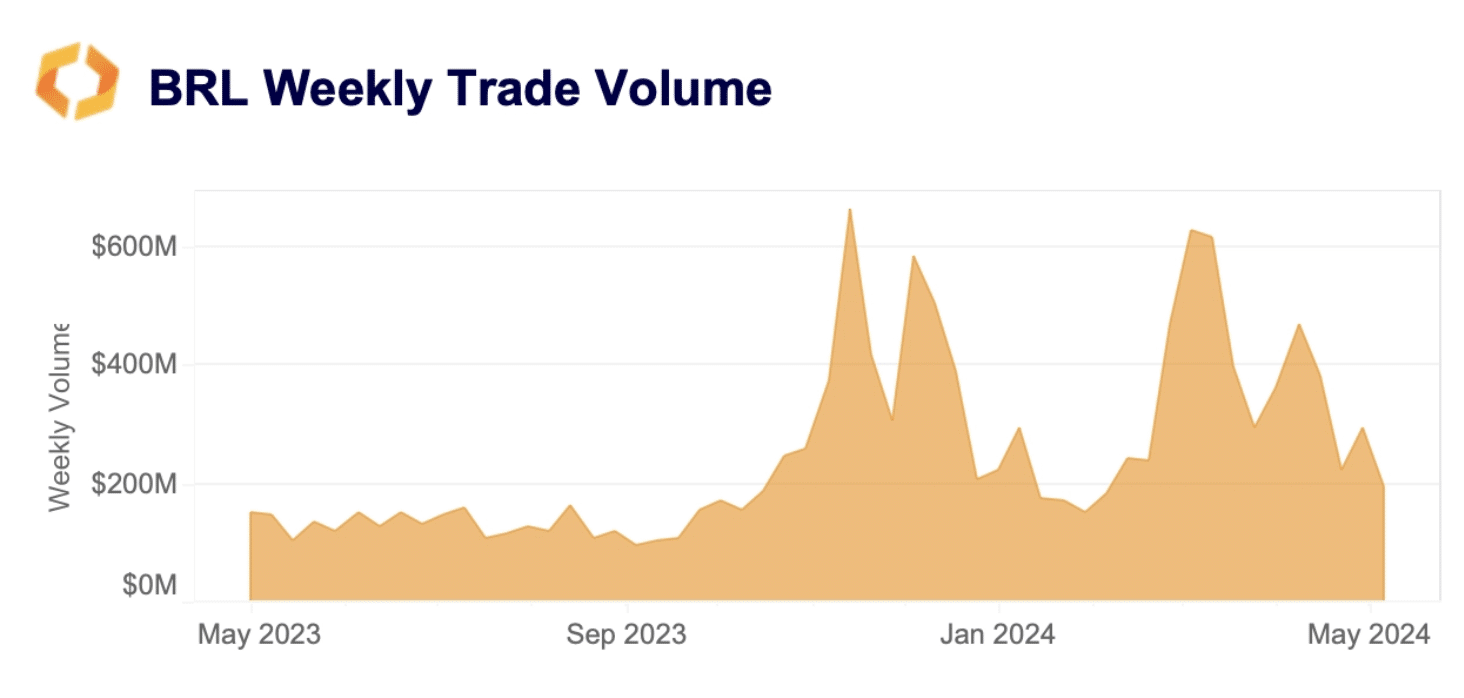News
How did Latin America become a major player in the cryptocurrency landscape?

Fractured Latin America is turning its attention to cryptocurrencies. What is happening in these countries?
Revision
Second Catenaanalysis research, Latin America is the seventh largest crypto economy globally, accounting for 7.3% of the market. Residents of the region often use digital assets as a store of value in the context of devaluing national currencies and as a weapon against authoritarianism.
Experts also point out that, by the end of 2023, a shift towards the mass adoption of blockchain and cryptocurrencies in everyday life will be underway, and Latin America will play a leading role in this. From mid-2022 to 2023, 51% of residents in the region purchased various items with digital currencies.
Source: Catenaanalysis
Circle attributes this dynamic to its strong developer base. Around one million people in the region are actively involved in offshore development. These developers have a significant impact on the local market, increasing the value and accessibility of Latin America’s financial sector.
“Taken together, Latin America’s established market demand, political support and widespread use of the dollar make the region a natural location for broader stablecoin adoption.”
Circle research
However, many other reasons have contributed to the active introduction or abandonment of cryptocurrencies in Latin America.
The most important countries in the implementation of cryptocurrencies: an overview
There are significant differences in patterns of digital asset use across jurisdictions in the region.
El Salvador
El Salvador is the first country in the world to recognize Bitcoin (Bitcoin) as legal tender. As part of his policy of supporting cryptocurrencies, the current president of the country, Nayib Bukele, promised to buy one BTC per day.
Now the Latin American state has accumulated more than $300 million in Bitcoin in two years. Bukele doesn’t seem to have any intention of selling Bitcoin – him he insists that BTC allows to develop tourism, innovation and the economy.
Additionally, El Salvador has launched several cryptocurrency initiatives. These include obtaining citizenship by investing in cryptocurrencies and mining BTC using volcanic energy.
Argentina
Last year, cryptocurrency advocate Javier Milei became President of Argentina. He promised to significantly reduce the public sector of the economy and government spending, fight triple-digit inflation, eliminate the Central Bank and replace the peso with the US dollar.
He is considered an outspoken opponent of central banks and supports Bitcoin, believing that the significant advantage of digital gold is its limited supply. After Milei’s victory in the presidential elections, the Bitcoin exchange rate against the Argentine peso approached an all-time high.
“With legal tender money they cheat you with the inflationary tax… #Bitcoin it is the natural reaction against central bank scammers; to make money private again.” – Javier Milei, President of Argentina 🇦🇷🇦🇷pic.twitter.com/Rs2yXFo4e7
— Dylan LeClair 🟠 (@DylanLeClair_) November 19, 2023
Since then, the country has seen an active increase in cryptocurrency loyalty. Currently, the country’s regulation of the digital assets sector is making progress. Therefore, in January, the Argentine government, led by the president, decided not to introduce a new tax on previously undeclared cryptocurrencies.
Additionally, Argentine regulators are discussing the regulation of Bitcoin and other digital assets with authorities in El Salvador. The countries intend to create a financial alliance in which Bitcoin will play a key role.
Representatives of the Argentine regulator praised the authorities of El Salvador for creating favorable conditions for the use of the first cryptocurrency and for developing legislation that allows cryptocurrency startups to grow in the country.
Paraguay
In October 2023, Bitcoin miner Sazmining launched the first agricultural company in Paraguay that runs entirely on renewable energy. The miner chose Paraguay for its vast energy potential and low tariffs.
Since, Paraguay has actively revised its policy towards Bitcoin miners, offering them more comfortable working conditions. This decision was made after considering a bill to ban mining, temporarily introduced in early April.
This strategy will allow the State to attract additional funds to finance infrastructure projects without increasing energy tariffs for the population. Therefore, Paraguay is easing its policy towards cryptocurrency miners, which could contribute to the development of the country’s mining industry.
Brazil
Second Kaiko, digital currency trading volume in Brazil increased by 30% in 2024. In the January-April period, the volume of cryptocurrency transactions exceeded $6 billion. Brazil ranks seventh in the world ranking of countries in terms of the volume of transactions with cryptocurrencies paired with fiat currency.

Source: Kaiko
Against the backdrop of widespread interest among citizens in cryptocurrencies, the Central Bank of Brazil is actively developing the regulation of digital assets. It is expected to be operational by the end of 2024.
The country’s authorities intend to launch a program to gradually introduce regulation of digital asset transactions. Initially, the Central Bank is implementing a plan to register crypto companies. They must obtain a license and enter a unique database of virtual service providers (VASP).
In the second phase, greater control over virtual currency transactions will begin. Particular attention will be paid to the supervision of stablecoins.
Mexico
In 2018, Mexico became the first country in Latin America to begin regulating cryptocurrency exchanges and other platforms used for cryptocurrency transactions.
Chainalysis experts say that Mexico is now the second-largest country in the world when it comes to cross-border crypto transactions. Approximately $61 billion worth of assets are transferred each year, mostly from the United States.
Updates on the legal regulation of cryptocurrencies in Mexico are needed. However, the country’s authorities are actively working on digital weight.
“Industry players will likely be interested to see whether that share will increase in the coming years, both for Mexico and other Latin American countries with large remittance markets.”
Research on the analysis chain
The regulator intends to implement functions such as automation mechanisms and programmability with the help of the asset. In 2023, the Bank of Mexico pushed up the timeline for the digital shot put from 2024 to 2025.
summing up
Ripio CEO Sebastian Serrano he admits that Latin America is becoming a development center for the global cryptocurrency market. Retail investors are showing the most significant interest in the tokens. Companies are also gradually switching to this tool, which allows for the free movement of capital around the world.
Therefore, the use of cryptocurrencies in Latin America will increase in the coming years. Brazilian importers are already using virtual currencies to pay Chinese suppliers of goods.
News
Cryptocurrency Price August 1: Bitcoin Dips Below $65K; Solana, XRP Down Up To 8%

Major cryptocurrencies fell in Thursday trading following the Federal Reserve’s decision to keep its key interest rate unchanged. Overnight, the U.S. Federal Reserve kept its key interest rate at 5.25-5.5% for the eighth consecutive time, as expected, while also signaling the possibility of a rate cut at its next meeting in September. The unanimous decision by the Federal Open Market Committee reflects a continued wait-and-see approach as it monitors inflation trends.
CoinSwitch Markets Desk said: “Bitcoin has fallen below $65,000 after the US Federal Reserve announced it would keep interest rates unchanged. However, with markets now anticipating rate cuts at the next Federal Reserve meeting in September, the outlook for a Bitcoin rally by the end of the year has strengthened.”
Meanwhile, CoinDCX research team said: “The crypto market has plunged after the Fed decision. Tomorrow’s US unemployment rate announcement is expected to induce more volatility, with the ‘actual’ figure coming in higher than the ‘expected’ one, which is positive for cryptocurrencies.”
At 12:21 pm IST, Bitcoin (BTC) was down 3.2% at $64,285, while Ethereum was down nearly 4.5% at $3,313. Meanwhile, the global market cryptocurrency The market capitalization fell 3.6% to around $2.3 trillion in the last 24 hours.
“Bitcoin needs to clear its 200-day EMA at $64,510 to consolidate further. Otherwise, a retest of $62,000 could be in the cards,” said Vikram Subburaj, CEO of Giottus.
Altcoins and meme coins, such as BNB (3%), Solana (8%), XRP (5.7%), Dogecoin (5%), Cardano (4.6%), Avalanche (4.3%), Shiba Inu (3.8%), Polkadot (3.4%), and Chainlink (4%) also saw declines.
The volume of all stablecoins is now $71.64 billion, which is 92.19% of the total cryptocurrency market volume in 24 hours, according to data available on CoinMarketCap. Bitcoin’s dominance is currently 54.99%. BTC volume in the last 24 hours increased by 23.3% to $35.7 billion.
(Disclaimer: Recommendations, suggestions, opinions and views provided by experts are personal. They do not represent the views of the Economic Times)
(You can now subscribe to our ETMarkets WhatsApp Channel)
News
Altcoins WIF, BONK, RUNE, JUP Down 10% While Bitcoin Drops 4%

Altcoins dogwifhat, Bonk, THORChain, and Jupiter have suffered losses of more than 10%, while Bitcoin is down 4% in the last 24 hours.
After a period of relative calm yesterday, July 31, Bitcoin (BTC) price action has seen a drastic change as the cryptocurrency dropped by more than $3,500, bringing its value to $63,300. At the same time, altcoins mirrored this trend, with the total value of liquidated positions rising to nearly $225 million over the course of the day.
Initially, the week started on a positive note for Bitcoin, which reached its highest point since early June, hitting $70,000. However, this peak was short-lived, as it was quickly rejected, leading to a substantial decline, with Bitcoin falling below $65,500.
The cryptocurrency managed to regain some stability, trading comfortably at around $66,800. However, following a Press conference According to Federal Reserve Chairman Jerome Powell, the value of Bitcoin has fallen again to $64,300, down more than 3% in 24 hours.
BTC Price Chart 24 Hours | Source: crypto.news
The recession coincided with a relationship from the New York Times stating that Iran had called for retaliatory measures against Israel following the assassination of Hamas leader Ismail Haniyeh in Tehran, increasing the risk of further conflict in the region.
Meanwhile, on the economic front, the Federal Reserve decided to keep its benchmark interest rates in place, offering little information on a planned September rate cut. Powell also hinted that while no concrete decisions have been made on the September adjustment, there is growing consensus that a rate cut is likely.
Amid Bitcoin’s decline, altcoins have suffered even more significant losses. For example, dogwifhat (Wife) saw a 12.4% drop and (DISGUST) has suffered a 10% drop. Other altcoins such as THORChain (RUNE) also fell by 10%, while Jupiter (JUPITER) and the Ethereum naming service (ENS) decreased by 8% and 9% respectively.
Among the largest-cap cryptocurrencies, the biggest losers are Solana (SOL) with a decrease of 8%, (Exchange rate risk) down 6%, Cardano (ADA) down 4%, and both Ethereum (ETH) and Dogecoin (DOGE) recording a decrease of 4.4%.
Data from CoinGlass indicates that approximately 67,000 traders have been negatively impacted by this increased volatility. BTC positions have seen $61.85 million in liquidations, while ETH positions have faced $61 million. In total, the value of liquidated positions stands at $225.4 million at the time of writing.
News
Riot Platforms Sees 52% Drop in Bitcoin Production in Q2

Bitcoin mining firm Riot Platforms has released its second-quarter financial results, highlighting a decline in cryptocurrency mined due to the recent halving.
Colorado-based Bitcoin (BTC) mining company Riot platforms revealed its second quarter financial results, highlighting a significant reduction in mined cryptocurrencies attributed to the recent halving event that took place in early April.
The company reported total revenue of $70 million for the quarter ended July 31, a decline of 8.7% compared to the same period in 2023. Riot Platforms attributed the revenue decline primarily to a $9.7 million decrease in engineering revenue, which was partially mitigated by a $6 million increase in Bitcoin extraction income.
During the quarter, the company mined 844 BTC, representing a decline of over 50% from Q2 2023, citing the halving event and increasing network difficulty as major factors behind the decline. Riot Platforms reported a net loss of $84.4 million, or $0.32 per share, missing Zacks Research forecast a loss of $0.16 per share.
Halving increases competitive pressure
The Colorado-based firm said the average cost of mining one BTC in the second quarter, including energy credits, rose to $25,327, a remarkable 341% increase from $5,734 per BTC in the same quarter of 2023. Despite this significant increase in production costs, the firm remains optimistic about maintaining competitiveness through recent deals.
For example, following the Recent acquisition Cryptocurrency firm Block Mining, Riot has increased its distributed hash rate forecast from 31 EH/s to 36 EH/s by the end of 2024, while also increasing its 2025 forecast from 40 EH/s to 56 EH/s.
Riot Platforms Hashrate Growth Projections by 2027 | Source: Riot Platforms
Commenting on the company’s financials, Riot CEO Jason Les said that despite the halving, the mining company still managed to achieve “significant operational growth and execution of our long-term strategy.”
“Despite this reduction in production available to all Bitcoin miners, Riot reported $70 million in revenue for the quarter and maintained strong gross margins in our core Bitcoin mining business.”
Jason Les
Following its Q2 financial report, Riot Platforms shares fell 1.74% to $10.19, according to Google Finance data. Meanwhile, the American miner continues to chase Canadian rival Bitfarms, recently acquiring an additional 10.2 million BITF shares, increasing its stake in Bitfarms to 15.9%.
As previously reported by crypto.news, Riot was the first announced a $950 million takeover bid for Bitfarms in late May, arguing that Bitfarms’ founders were not acting in the best interests of all shareholders. They said their proposal was rejected by Bitfarms’ board without substantive engagement.
In response, Bitfarms She said that Riot’s offer “significantly understates” its growth prospects. Bitfarms subsequently implemented a shareholder rights plan, also known as a “poison pill,” to protect its strategic review process from hostile takeover attempts.
News
Aave Price Increases Following Whales Accumulation and V3.1 Launch

Decentralized finance protocol Aave is seeing a significant spike in whale activity as the market looks to recover from the recent crash that pushed most altcoins into key support areas earlier this week.
July 31, Lookonchain shared details indicating that the whales had aggressively accumulated Aave (AAVE) over the past two days. According to the data, whales have withdrawn over 58,848 AAVE worth $6.47 million from exchanges during this period.
In one instance, whale address 0x9af4 withdrew 11,185 AAVE worth $1.23 million from Binance. Meanwhile, another address moved 21,619 AAVE worth over $2.38 million from the exchange and deposited the tokens into Aave.
These withdrawals follow a previous transfer of 26,044 AAVE from whale address 0xd7c5, amounting to over $2.83 million withdrawn from Binance.
AAVE price has surged over 7% in the past 24 hours amid buy-side pressure from these whales. The DeFi token is currently trading around $111 after jumping over 18% in the past week.
Recently, the price of AAVE increased by over 8% after Aave founder Marc Zeller announced a proposed fee change aimed at adopting a buyback program for AAVE tokens.
Aave v3.1 is available
The total value locked in the Aave protocol currently stands at around $22 billion. According to DeFiLlamaApproximately $19.9 billion is on Aave V3, while the V2 chain still holds approximately $1.9 billion in TVL and V1 approximately $14.6 million.
Aave Labs announced Previously, Aave V3.1 was made available on all networks with active Aave V3 instances.
V3.1 features improvements that are intended to improve the overall security of the DeFi protocol. The Aave DAO governance has approved the v3.1 improvements, which also include operational efficiency and usability for the network.
Meanwhile, Aave Labs recently outlined a ambitious roadmap for the projectwith a 2030 vision for Aave V4, among other developments.
-

 Regulation7 months ago
Regulation7 months agoRipple CTO and Cardano founder clash over XRP’s regulatory challenges ⋆ ZyCrypto
-

 Regulation5 months ago
Regulation5 months agoNancy Pelosi Considers Supporting Republican Crypto Bill FIT21 – London Business News
-

 Videos6 months ago
Videos6 months agoCryptocurrency News: Bitcoin, ETH ETF, AI Crypto Rally, AKT, TON & MORE!!
-

 Regulation6 months ago
Regulation6 months agoBitcoin’s future is ‘bleak’ and ripe for regulation, says lead developer
-

 News6 months ago
News6 months agoThe trader earned $46 million with PEPE after reaching a new ATH
-

 Blockchain6 months ago
Blockchain6 months agoSolana ranks the fastest blockchain in the world, surpassing Ethereum, Polygon ⋆ ZyCrypto
-

 Blockchain6 months ago
Blockchain6 months agoSolana Surpasses Ethereum and Polygon as the Fastest Blockchain ⋆ ZyCrypto
-

 Regulation6 months ago
Regulation6 months ago🔒 Crypto needs regulation to thrive: Tyler Cowen
-

 Videos6 months ago
Videos6 months agoWho Really CONTROLS THE MARKETS!! Her plans REVEALED!!
-

 Videos7 months ago
Videos7 months agoKucoin safe?? Exchange REVIEW and beginner’s guide!!
-

 Blockchain6 months ago
Blockchain6 months ago“Liquid vesting” is an oxymoronic feature of blockchain that allows early investors to sell without waiting
-

 Videos6 months ago
Videos6 months agoInstitutions purchasing MEMECOINS?! Everything you need to know!





